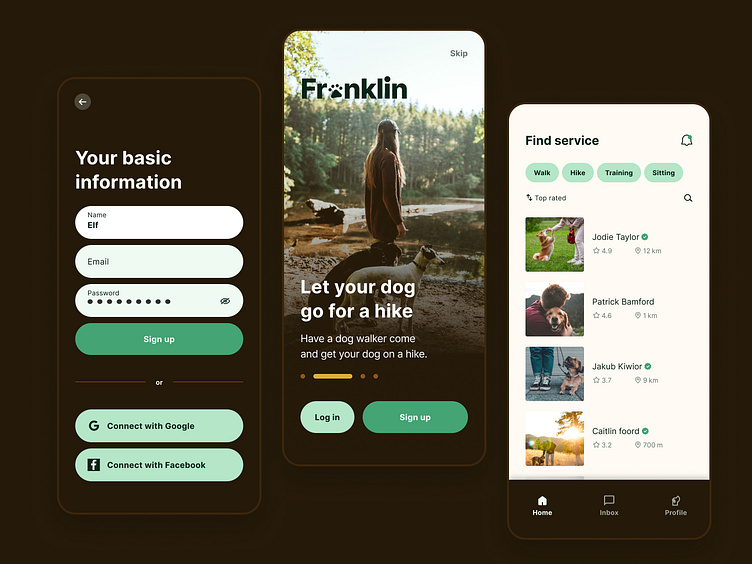Fr🐾nklin – Dog walking app
As a part of Dribbble's Product Design Course, I created this Dog Walking App that I chose to call Fr🐾nklin — aimed at making it easier for dog owners to find dog walkers and sitters for the four-legged ones.
The method introduced and used in this course is a seven step process: Research and empathise, Define requirements, Ideate, Prototype, Test, Refine and deliver, and finally, Measure and analyse.
Research and empathise
To kickstart the assignment, I did some user research and interviewed a few dog owners in my circle of friends. Getting a better view of what features the app needs so dog owners could consider using an app of this nature. Also, to gain insight into dog owners' needs to get solved.
Inspired by these interviewers, I designed a user persona from their shared characteristics, which became the persona I designed the app for. Using a user persona, I found a beneficial tool to make decisions with.
Define requirements
As part of the research process, I also did a competitive analysis, further deepening my understanding of the landscape that my app would be part of. Using the data from the competitive analysis, user research and the user persona – that was unique in her way, opportunities arose for how my version could be unique.
How would my user persona sign up for the app, and how would she book herself a dog walker?
Ideate
Moment for brainstorming and creativity. Little by little, the idea started to grow and to grasp it, I started visualising the user flow—a helpful method to gain a bird's view of the app layout.
Satisfied with the outcome I started drawing wireframes and exploring how this new app might look and function in the real pixelated world it would live in.
Furthermore, doing a mood board and visual exploration, I devised a styleguide dominated by earth colours since they best fit the user persona.
Prototype
Starting as a low-fidelity wireframe, the more detailed it got, the closer it got to becoming a high-fidelity prototype. Going back and forth in the process few things changed, like the user flow. I decided to simplify the sign-up flow and add a feature to the book-a-walker flow.
Test
By sharing the prototype with people around me, I got useful feedback and further developed the app. For instance, I learned that reviews were important to gain the trust of the dog walker. So I made it more prominent on the user profile.
Refine and deliver
The deadline approaching. It is time to refine the design and prepare for delivery. Doing the documentation is essential; while doing it, I would fix some bugs that became evident while doing the documentation.
Measure and Analyse
The final step, if this was a complete app, would be to launch the app. However, the work does not stop there. After that, the time would come to review its performance and use feedback to improve your product.
Going through this process with my fellow students and mentor was something I could recommend to anyone interested in product design. The setup was great, where we would learn from each other by sharing our thoughts and struggle that was met with insightful guidance by our mentor.







